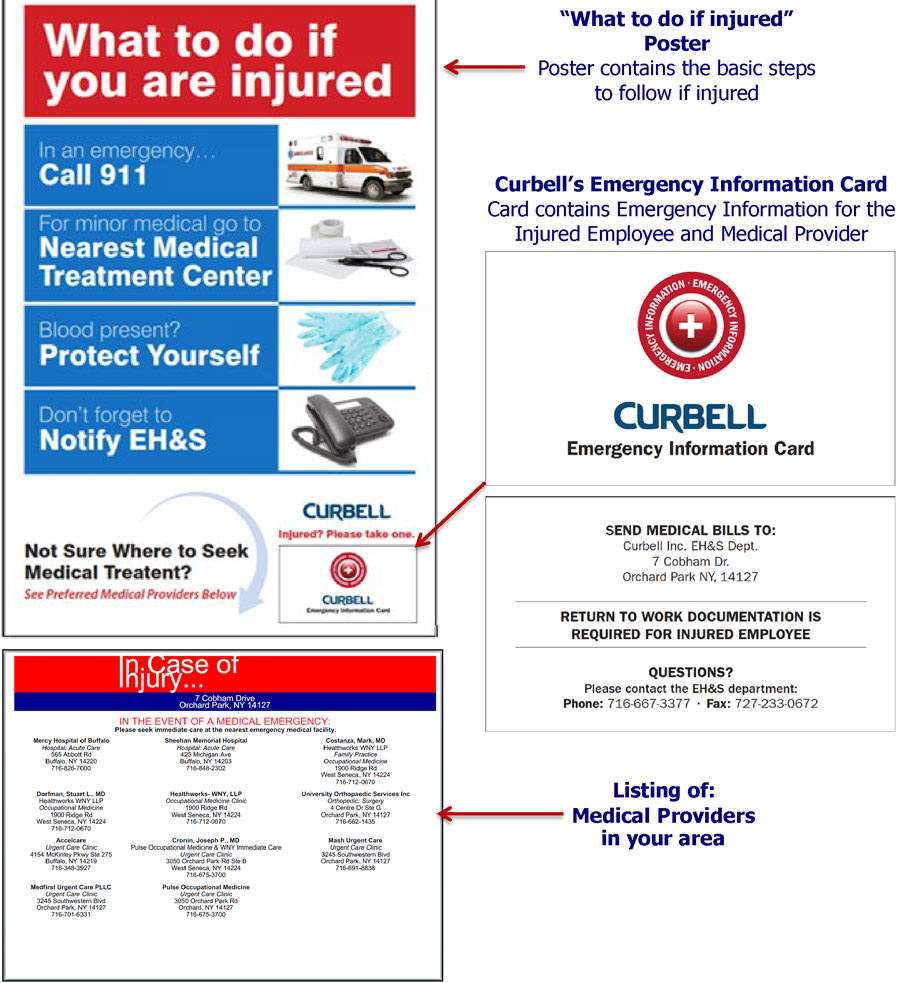StaySafe
orkplace safety is about prevention. Assessing the workplace for hazards and putting barriers in place to prevent incidents from occurring are an essential function and responsibility for any business. It is not only the law but a benefit as well. By doing so we reduce risk and costs to the organization as well as the employees. Unfortunately, there are no sure things in life and accidents will happen. When they do, preparation is key.
Injuries do not happen often but when they do, excitement and even panic can take over. For businesses that do not have on-staff medical professionals, knowing what to do and responding effectively is critical. It can reduce the severity of the injury and prevent others from being injured. Organizations should create a plan that includes:
- Identifying responsibilities and training employees regularly on what to do if an injury occurs. This should include such things as empowering employees to call 911, identifying who needs to be alerted and who will make decisions on securing the area and cleanup.
- Find a nearby healthcare provider ahead of time. During training, communicate this information with employees. Having a designated healthcare provider can take the guesswork out of where to go for injuries that are not an emergency, but require medical attention.
- Keep it simple and take the guesswork out of it. Along with regular training, there should be reminders, such as posters in common areas, with vital information and directions.
- First aid supplies and equipment should be available, up-to-date and accessible.
- Collect emergency contact information for all employees. Identify who will make contact if necessary.
NOTE: It is important that the decision to call 911 or to seek medical attention is not at the discretion of the victim. Employees should be encouraged and supported to make that quick decision.

By being prepared, you can act quickly. If there is an emergency, the first thing to do is to determine its severity. Train employees to follow these three easy steps:
- If there’s an emergency or if you aren’t sure, call 911! Don’t hesitate!
- If it isn’t an emergency, but medical attention is needed, have a plan in place to get the injured employee to the nearest healthcare provider.
- For minor injuries, ensure that first aid supplies are available.
After taking care of the injured employee, the next step is to make sure the area is secure. Doing so will help to prevent additional injuries, prevent exposure to bloodborne pathogens and allow for an unabridged investigation.
Begin an investigation immediately. By securing the area and starting an investigation right after the situation has been controlled, the evidence will be undisturbed and everything will be fresh in people’s minds. Take pictures and interview witnesses and employees who may have information about what happened. Document all information related to the incident and secure all physical evidence. This will help to identify the root cause and assist in determining a corrective action.
Even if the employee says they are fine, document the injury. Write down the relevant details and gather witness testimonies while the incident is still clear in everyone’s mind. Take pictures of the scene, review video footage and keep any equipment or other evidence of the accident secured in order to clarify any disputes. Always ask the victim to write a statement about the incident. Do this as soon as practicable after the incident.
The information collected during your incident investigation will also help you determine your next steps. You may be required to record the injury or report it to OSHA, Cal/OSHA or other state or local authorities in your jurisdiction. To understand your responsibilities, refer to:
- www.osha.gov/recordkeeping
- www.dir.ca.gov/dosh/dosh_publications/cal_fed.html
- Check with your state Department of Labor
Depending on the type and severity of the injury, you may need to report it to your workers’ compensation insurance provider. This information can be useful in case management as well as decisions on compensability.
Ensure that any necessary documentation or instructions are given to the employee and/or the medical provider. Early communication between the injured employee, their medical provider and/or the insurance company will help to smooth the employee’s return to work, especially if there are restrictions.
Your preparation will have determined internal communications and responsibilities as well. That may include upper management and the human resources department. You may need to call the injured employee’s emergency contact.
It’s also important to give consideration to co-workers. When people see or hear about one of their colleagues getting hurt, they will be concerned. Due to privacy laws, you may not share medical information about the employee with their coworkers. However, you can — and should — take the time to listen to their concerns. Good communication can help answer questions, relieve anxiety and lead to suggestions for improvements. It also gives you the opportunity to make sure everyone understands the company’s concern and commitment to the well-being of all employees.
The only good thing that can come from an accident is knowledge and experience. This information can help prevent future injuries from happening. Assess the accident and develop ideas for reducing the opportunity for it to happen again. Work with employees and those that know the job well. Document the corrective action. Test it out. If it works, train on it and implement the change. Periodically review it.
In conclusion, businesses have several important responsibilities, but employee safety and health must be a priority. Injuries are bound to happen, but it’s how you respond that will dictate the outcome. Having a risk and response plan in effect will save valuable time at crucial moments and ensure the best outcome to a bad situation.
Mark Shriver is the director of safety and environmental affairs at Curbell, Inc. For more information, contact Curbell, Inc. at 7 Cobham Drive, Orchard Park, NY 14127 USA; phone (716) 667-3377, fax (727) 233-1703, marketing@curbellplastics.com or www.curbellplastics.com.